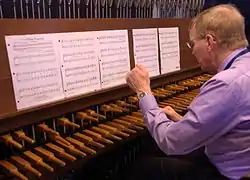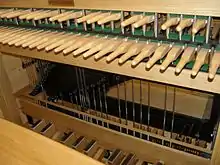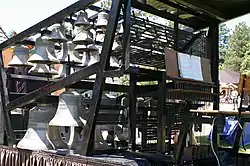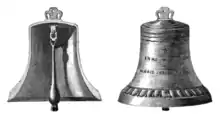Carillon
A carillon[lower-alpha 1] is an idiophone percussion instrument that is played with a keyboard and consists of at least 23 cast bronze bells in fixed suspension and tuned in chromatic order so that they can be sounded harmoniously together. Usually housed in a bell tower, the bells are struck with clappers, which are connected to a keyboard of wooden batons played with the hands and pedals played with the feet. Often, carillons include an automatic system through which the time is announced (via the Westminster Quarters, for example) and simple tunes are played.


Carillons come in a wide variety of appearances, weights, sizes, and sounds. It is one of the world's heaviest instruments, with the heaviest carillon weighing in at over 91 metric tons (100 short tons). A minimum of 23 bells are needed to be called a carillon by those who play and study them. "Concert sized" instruments have about 50, and the world's largest has 77 bells. The appearance of a carillon is dependent on the number and weight of the bells and the tower in which it is housed. They may be found in towers connected to buildings or free-standing, and a small minority are fixed to a frame that enables them to be transported. The bells of the carillon may be directly exposed to the elements or hidden away inside the structure of their tower.
The origins of the carillon can be traced back to the Low Countries—Belgium, the Netherlands, and the French Netherlands—in the 16th century. The modern carillon was said to be invented in 1644 when Jacob van Eyck and the Hemony brothers cast the first tuned carillon.
Today, there are approximately 686 carillons worldwide. Unsurprisingly, the majority are concentrated around its place of origin, though nearly 200 have been constructed in North America. The majority of extant carillons were constructed in the last two centuries.
Etymology and terminology
| Look up carillon in Wiktionary, the free dictionary. |
The word carillon is a loanword from the French language dating back to the late eighteenth century. It is derived from the Old French carignon (an alteration of quarregon), meaning "a set of four bells." The word quarregon originates from the Latin quaternionem, meaning "set of four"; from quater ("four times").[2] In German, in addition to using the French term, a carillon is sometimes called a Glockenspiel (lit. "play of bells"), not to be confused with the glockenspiel.
A musician who plays the carillon is commonly called a carillonneur, also loaned from French. It and carillon were adopted by English speakers after the introduction of the instrument to British troops during the War of Spanish Succession.[3] Though the word carillonneur literally refers to carillon players that are men, the French carillonneuse to denote women is not used. Another common term is carillonist, which some players of the carillon have wished for it to replace carillonneur due to the former's simple spelling and unambiguous pronunciation.[4]
Characteristics
Construction

The carillon is a keyboard instrument. Though it shares similarities with other instruments in this category, such as the organ or pedal piano, its playing console is distinct.[5] Playing with the hands is done on a manual keyboard composed of rounded wooden batons. Like a piano, the manual has short chromatic keys (i.e. "black keys") raised above the diatonic ones ("white keys") and arranged in the same manner; however, they are spaced far apart—about 46 millimetres (1.8 in)—and the chromatic keys are raised 97 millimetres (3.8 in) above the rest.[6] To operate, the keys are depressed approximately 40 to 55 millimetres (1.6 to 2.2 in) with a closed fist.[7] In addition, the bottom 1.5 to 2.5 octaves of the manual are connected to a pedalboard, which is played with the feet. The connection is direct, meaning that when a pedal is pressed, its corresponding key on the manual is pulled down with it.[8][5] Unlike the organ or pedal piano, the carillon's pedals are shorter and fatter (232 by 30 millimetres (9.1 by 1.2 in) for diatonic pedals and 110 by 30 millimetres (4.3 by 1.2 in) for chromatic pedals), and spaced far apart, about 85 millimetres (3.3 in).[6] They are typically arranged with a slight radiation and concavity on North American carillons and without those features on European equivalents.[7]

Each key is connected to a transmission system via a wire, usually made of stainless steel. When a particular key is depressed, it pulls on the wire which, after interacting with other wires and pulleys, causes a clapper to swing towards the inner wall of the key's corresponding bell. At rest, these clappers are about 50 millimetres (2.0 in) away from the bell wall.[8] For larger bells, gravity is sufficient to pull the clapper back from the bell. Smaller bells are fitted with return springs to pull it back immediately after the stroke, so that the bell is not sounded more than once for each keystroke.[5] Immediately above each key is an adjuster that allows the performer to compensate for changes in wire length due to temperature changes.[8]
The cast bronze, cup-shaped bells of a carillon are housed at the top of a tower in a structure typically made of steel or wooden beams. The arrangement of the bells is highly dependent on the available space, the height and construction of the tower, and the number and size of bells. When the heaviest bells are especially large, they are usually placed below the playing cabin in order to achieve a better tonal distribution.[9] The bells themselves do not move during operation, only the clappers.[10] However, with some instruments, the heaviest bells may be outfitted with a mechanism enabling them to swing. Carillons may also feature an automatic mechanism by which simple tunes or the Westminster Quarters are played.[8]

Sound
Carillon bells are made of bell bronze, a specialized copper-tin alloy used for its above-average rigidity and resonance.[11] A bell's weight and profile, or shape, determine its note and the quality of its tone. It produces a sound with overtones or partial tones are not necessarily harmonically related.[12] To produce a pleasing, harmonically related series of tones, the bell's profile must be carefully adjusted. Bellfounders typically focus on five principal tones when tuning, most notably the minor third overtone called the tierce, which gives rise to the unique sound of carillons and has been the subject of additional research.[9] Since the casting process does not reliably produce perfectly tuned bells, they are cast slightly thicker and metal is shaved off with a lathe. Once finished, a bell never loses its sound profile. Only fires and air pollution will destroy a bell after it is founded.[13] On older European carillons, bells were tuned with each other by using the meantone temperament tuning system. Modern carillons, particularly those in North America, are tuned to equal temperament.[14]
The carillon has dynamic range similar to that of a piano's, if not more. Through variation of touch, performers are able to express a wide variety of volumes. Bigger bells have more dynamic range than small high bells. Higher-pitched bells, with less bell mass, can only reach a fraction of the volume of the bass bells.[14]
Along with pipe organs, carillons are one of the world's heaviest musical instruments. Most carillons weigh between 4.5 and 15 metric tons (5.0 and 16.5 short tons), with extremes ranging from very light 1 metric ton (1.1 short tons) instruments to the world's heaviest at over 91 metric tons (100 short tons)—the Laura Spelman Rockefeller Memorial Carillon of the Riverside Church in New York City. It's bourdon or largest bell is the largest tuned bell ever cast for a carillon, which sounds a full octave below most other bourdons.[15][16] With weight not standardized across the population, the same music will sound different on each carillon.
Range
The range of the carillon is directly proportional to the number of bells it has. The instrument's total number of bells usually depends on funds available for the creation of the instrument: more money allows more bells to be cast, especially the larger, more costly ones. It is generally accepted that a carillon must have at minimum 23 bells, or else it is called a chime.[10][15][14][17][18][19] There is no standard pitch range for the carillon,[14] and as a result, several subcategories are used to categorize them:
- Carillons with 23 to 27 bells and 35 to 39 bells are classified as two-octave and three-octave carillons, respectively. Players of these instruments often use music written specifically for the limited ranges.
- A "concert" or "standard" carillon has typically 45 to 50 bells, or a range of about four octaves.
- Carillons with more than 50 bells are referred to as "great" or "grand" carillons.
- Instruments with fewer than 23 bells and build before 1940 may be classified as a "historical carillon" by the World Carillon Federation.[17]
The title of world's largest carillon by number of bells is shared between two instruments: the carillon of the Kirk in the Hills Presbyterian Church in Bloomfield Hills, Michigan and the carillon at Daejeon Institute of Science and Technology in Daejeon, South Korea; both have 77 bells.[20]
Since a carillon is seldom played with another instrument, its bourdon may be any pitch—whichever is suitable for the location and funds available. It is common for the console to have a C-compass to simplify the writing and playing of music. As a result, many carillons are transposing instruments, especially those that are small or older.[18] The transposition can be anywhere from down a perfect fourth to up an octave.[14] In the United States, an increasing number of new carillons have been installed in concert pitch as a result of the desire to establish the carillon as a full-fledged concert instrument.[15]
History

In medieval times, swinging bells were first used as a way of notifying people of imminent church services, and for such as fires, storms, wars and other secular events.
However, the use of bells to play melodic musical compositions originated in the 16th century in the Low Countries. The first carillon was in Flanders, where a fool performed music on the bells of Oudenaarde Town Hall in 1510 by using a baton keyboard.
Major figures in the evolution of the modern carillon were Pieter and François Hemony working in the 17th century. They are credited as being the greatest carillon bell founders in the history of the Low Countries. They developed the carillon, in collaboration with Jacob van Eyck, into a full-fledged musical instrument by casting the first tuned carillon in 1644, which was installed in Zutphen's Wijnhuistoren tower.
Usage and repertoire
Music
Carillon music is typically written on two staves. Notes written in the bass clef are generally played by the feet. Notes written in the treble clef are played with the hands. Pedals range from the lowest note (the bourdon) and may continue up to two and half octaves. In the North American Standard keyboard, all notes can be played on the manual.
Because of the acoustic peculiarities of a carillon bell (the prominence of the minor third, and the lack of damping of sound), music written for other instruments needs to be arranged specifically for the carillon.
The combination of carillon and other instruments, while possible, is generally not a happy marriage. The carillon is generally far too loud to perform with most other concert instruments. The great exceptions to this are some late twentieth and early twenty-first century compositions involving electronic media and carillon. In these compositions, sound amplification is able to match the extreme dynamic range of the carillon and, in the case of sensitive composers, even the most delicate effects are possible. Brass music is often heard together with a (traveling) carillon.
Organization and education
The World Carillon Federation is the central organization of carillon players and enthusiasts. It was founded in the 1970s as a federation of the preexisting national or regional carillon organizations.[21] As of 2021, it is comprised of 14 member organizations:[17]
- British Carillon Society
- Brotherhood of Bell Ringers and Carillonists of Catalonia
- Carillon Society of Australia
- Dutch Carillon Association
- Flemish Carillon Association
- German Carillon Association
- Guild of French Carillonneurs
- Guild of Carillonneurs in North America
- Lithuanian Carillonist Guild
- Nordic Society for Campanology and Carillons
- Polish Carillon Association
- Russian Carillon Foundation
- Swiss Carillonneurs and Campanologists Guild
- Walloon Campanaire Association
The federation organizes an international carillon congress in one of the home countries of the member organizations every three years. The congresses host lectures, workshops, and committee meetings about the topics related to the carillon, for example: news, tutorials and demos, and research developments.[22] Most member organizations publish periodicals to update its members on the current state of carillon culture in their respective regions.[22]
Training to perform on a carillon can be obtained at several institutions, though the Royal Carillon School "Jef Denyn" remains the most sought-after educational program for the carillon in the world. Founded in 1922, it is the oldest and first school of its kind and has branches in several cities and affiliate schools.[22] The LUCA School of Arts in Leuven, Belgium offers a master's program in the carillon, and the Utrecht School of the Arts in Amersfoort, Netherlands has a dedicated school.[23] There are schools elsewhere in the United Kingdom,[24] France, and Denmark.[25]

The Guild of Carillonneurs in North America organizes carillon examinations during its annual congresses. Those who pass are certified as carillonneur-members of the guild. It also partners with the North American Carillon School, founded in 2012 as an affiliate of the Royal Carillon School "Jef Denyn."[22][26] Several American universities offer a carillon program within their curriculum.[22] The University of California, Berkeley,[27] the University of California, Santa Barbara,[28] the University of Michigan,[29] the University of Florida,[30] and the University of Denver[31] offer complete courses of study. Clemson University,[32] the University of Kansas,[33] Iowa State University,[34] Marquette University,[35] Grand Valley State University, and the University of Rochester offer limited credit for carillon performance. Employed carillonneurs at several universities and also those not employed at university-owned carillons offer private lessons.[26] Universities that possess a carillon but do not offer course credit often have a club or student-run education program, such as the Yale Guild of Carillonneurs, which manages performances on the Yale Memorial Carillon.[36]
Notable people
| * | Carillonneur | Composer for carillon |
|---|
- Georges-Jacques Aelsters (1770–1849)*

- Kathryn Alexander (b. 1955)

- Émilien Allard (1915–1976)*

- Mary Jeanne van Appledorn (1927–2014)

- Samuel Barber (1910–1981)

- Ronald Barnes (1927–1997)*

- Maria Blom*
- Johanna Bordewijk-Roepman (1892–1971)

- John Cage (1912–1992)

- Joseph Callaerts (1830–1901)*
- Adèle Colson (1905–1997)*
- John Courter (1941–2010)*

- George Crumb (b. 1929)

- Mary Mesquita Dahlmer (1897–1993)*
- Jef Denyn (1862–1941)*

- Emma Lou Diemer (b. 1927)

- Margriet Ehlen (b. 1943)

- Edward Elgar (1857–1934)

- Jacob van Eyck (c. 1590–1657)*
- Richard Felciano (b. 1930)

- Wim Franken (1922–2012)*

- Lyn Fuller (b. 1946)*

- Frans Geysen (b. 1936)

- Matthias van den Gheyn (1721–1785)*

- Bengt Hambraeus (1928–2000)

- Hans Uwe Hielscher (b. 1945)*
- Nora Johnston (1886–1952)*
- Monika Kaźmierczak*
- Hans Kockelmans (b. 1956)

- Giedrius Kuprevičius (b. 1944)

- Ulla Laage (b. 1949)*

- Libby Larsen (b. 1950)

- Lowell Liebermann (b. 1961)

- Jessie Montgomery (b. 1981)

- Ruth Muzzy Conniston Morize (1892–1952)*
- Arne Nordheim (1931–2010)

- Michiel Nouts (1628–1693)*
- Charlemagne Palestine (b. 1947)*

- Jean-Luc Perrot (b. 1959)*

- Vincent Persichetti (1915–1987)

- Wilbert Roget, II (b. 1983)

- Luc Rombouts (b. 1962)*
- Olesya Rostovskaya (b. 1975)*

- David Sargent (b. 1931)

- Gordon Slater (b. 1950)*

- Augusta Read Thomas (b. 1964)

- Merlijn Twaalfhoven (b. 1976)

- Roman Turovsky-Savchuk (b. 1961)

- Sally Slade Warner (1932–2009)*

- Gladys Elinor Watkins (1884–1939)*
- Wendell Westcott (1911–2010)*
- Charles Wuorinen (1938–2020)

- Julianne Vanden Wyngaard*
Distribution
Carillons across the world are registered and counted by the World Carillon Federation.[37] TowerBells is another carillon registry owned by Carl Scott Zimmerman, which provides a list of carillons and their technical specifications.[38] There are additional registries that specialize in specific types of carillons, such as the War Memorial and Peace Carillons registry, which counts carillons that serve as war memorials or were built in the name of promoting world peace.[39] According to the registries, there are approximately 686 carillons in the world. At least three can be found on every continent except Antarctica; however, of the 30 countries in which carillons can be found, only 11 have more than four. The "great carillon" countries[40]—the Netherlands, Belgium, and the United States—account for almost 70 percent of the world total. The concentration of carillons is highest in Europe, unsurprisingly centered on the Low Countries where the instrument originated.
 The National Carillon, a 55-bell, free-standing carillon in Canberra, Australia
The National Carillon, a 55-bell, free-standing carillon in Canberra, Australia The Thomas Rees Memorial Carillon, a 67-bell carillon in Springfield, Illinois, U.S.
The Thomas Rees Memorial Carillon, a 67-bell carillon in Springfield, Illinois, U.S. The Peace Tower in Ottawa, Canada, home to a 53-bell carillon
The Peace Tower in Ottawa, Canada, home to a 53-bell carillon The Carillon in Berlin-Tiergarten, a 68-bell carillon in Berlin, Germany
The Carillon in Berlin-Tiergarten, a 68-bell carillon in Berlin, Germany The tower of St. Rumbold's Cathedral in Mechelen, Belgium, home to two 49-bell carillons (one is rarely used)
The tower of St. Rumbold's Cathedral in Mechelen, Belgium, home to two 49-bell carillons (one is rarely used)
| Country | Carillons[lower-alpha 2] | Land area | Carillon density | ||
|---|---|---|---|---|---|
| km2 | sq mi | per 1,000 km2 | per 1,000 sq mi | ||
| Australia | 3 | 7,633,565 | 2,947,336 | 0.00026 | 0.00068 |
| Austria | 2 | 82,445 | 31,832 | 0.024 | 0.063 |
| Belgium | 72 | 30,278 | 11,690 | 2.378 | 6.16 |
| Bermuda | 1 | 54 | 21 | 19 | 48 |
| Brazil | 3 | 8,460,415 | 3,266,584 | 0.00024 | 0.00061 |
| Canada | 11 | 9,093,507 | 3,511,023 | 0.00121 | 0.00313 |
| China | 1 | 9,326,410 | 3,600,950 | 0.00011 | 0.00028 |
| Cuba | 1 | 109,884 | 42,426 | 0.009 | 0.024 |
| Curaçao | 1 | 444 | 171 | 2.3 | 5.8 |
| Denmark | 29 | 42,434 | 16,384 | 0.660 | 1.709 |
| Egypt | 1 | 995,450 | 384,350 | 0.0010 | 0.0026 |
| El Salvador | 1 | 20,721 | 8,000 | 0.048 | 0.12 |
| France | 73 | 543,940 | 210,020 | 0.1342 | 0.3476 |
| Germany | 48 | 348,672 | 134,623 | 0.1377 | 0.357 |
| Honduras | 1 | 111,890 | 43,200 | 0.009 | 0.023 |
| Ireland | 1 | 68,883 | 26,596 | 0.015 | 0.038 |
| Israel | 1 | 20,330 | 7,850 | 0.049 | 0.13 |
| Japan | 3 | 364,546 | 140,752 | 0.0082 | 0.021 |
| Lithuania | 3 | 62,680 | 24,200 | 0.048 | 0.124 |
| Luxembourg | 1 | 2,586 | 998 | 0.39 | 1.0 |
| Mexico | 3 | 1,943,945 | 750,561 | 0.00154 | 0.0040 |
| Netherlands | 184 | 33,893 | 13,086 | 5.429 | 14.06 |
| New Zealand | 1 | 262,443 | 101,330 | 0.0038 | 0.010 |
| Nicaragua | 1 | 119,990 | 46,330 | 0.008 | 0.022 |
| Norway | 12 | 304,282 | 117,484 | 0.0394 | 0.102 |
| Philippines | 1 | 298,170 | 115,120 | 0.0034 | 0.009 |
| Poland | 2 | 311,888 | 120,421 | 0.0064 | 0.017 |
| Portugal | 3 | 91,119 | 35,181 | 0.033 | 0.085 |
| Russia | 2 | 16,377,742 | 6,323,482 | 0.000122 | 0.00032 |
| South Africa | 3 | 1,214,470 | 468,910 | 0.0008 | 0.0021 |
| South Korea | 1 | 99,909 | 38,575 | 0.010 | 0.026 |
| Spain | 4 | 498,980 | 192,660 | 0.0080 | 0.0208 |
| Suriname | 1 | 156,000 | 60,000 | 0.006 | 0.017 |
| Sweden | 14 | 410,335 | 158,431 | 0.0341 | 0.0884 |
| Switzerland | 5 | 39,997 | 15,443 | 0.125 | 0.32 |
| Ukraine | 1 | 579,300 | 223,700 | 0.0017 | 0.0045 |
| United Kingdom | 15 | 241,930 | 93,410 | 0.0579 | 0.150 |
| United States | 174 | 9,147,643 | 3,531,925 | 0.0186 | 0.0481 |
| Uruguay | 1 | 175,015 | 67,574 | 0.0057 | 0.015 |
| Venezuela | 1 | 882,050 | 340,560 | 0.0011 | 0.0029 |
| World | 686 | 148,940,000 | 57,510,000 | 0.004606 | 0.011929 |
Traveling carillons

Traveling or mobile carillons are those which are not housed in a tower. Instead, the bells and playing console are installed on a frame that allow it to be transported. These carillons have to be much lighter than their non-mobile counterparts. According to a count by the World Carillon Federation, there are 18 existing mobile carillons. Three are headquartered in Belgium, two in France, two in Germany, two in Japan, two in the Netherlands, two in the United States, one in the Czech Republic, one in Denmark, one in Poland, one in Portugal, and one in Spain.[41]
The two American traveling carillons are part of the musical group Cast in Bronze, which features the carillon in concert with other instruments or a recording. The group is owned by Frank DellaPenna, who performs in a costume named "The Spirit of the Bells." He is credited with introducing the carillon to the general public of the United States in his mission to promote and preserve the carillon art.[42]
Notes
References
- "Carillon—Definition, Pictures, Pronunciation and Usage Notes". Oxford Learners Dictionaries. Retrieved 5 February 2021.
- "Carillon". Online Etymology Dictionary. Archived from the original on 1 January 2019. Retrieved 31 January 2021.
- Price 1983, p. 222: "The player of this unique keyboard is known in Flemish as a beiaardier and in French as a carillonneur, which last term was also adopted in English after the campaigns of Marlborough brought British troops on to Flemish soil and gave a British march to be chimed from Flemish towers."
- Barnes 2014, p. 41.
- Rech, The Carillon: The Playing Techniques: The Hand Playing.
- Courter, et.al. 2006, p. 2.
- Courter, et.al. 2006, p. 3.
- "Playing Mechanism". Guild of Carillonneurs in North America. Archived from the original on 23 January 2021. Retrieved 1 February 2021.
- Rech, The Carillon: How the Carillon Works.
- Rice 1914, p. 23.
- Rombouts 2014, p. 45.
- Price 1983, p. 210.
- "Carillon Bells". Guild of Carillonneurs in North America. Archived from the original on 23 January 2021. Retrieved 1 February 2021.
- Brink 2017.
- Rombouts 2014, p. 310.
- "Carillon". Music at Riverside. The Riverside Church in the City of New York. Archived from the original on 3 December 2020. Retrieved 6 February 2021.
- "Organization". World Carillon Federation. Retrieved 31 January 2021.
- "A Musical Instrument". Guild of Carillonneurs in North America. Archived from the original on 23 January 2021. Retrieved 7 February 2021.
- "Carillon". Encyclopedia Britannica. Archived from the original on 29 October 2020. Retrieved 7 February 2021.
- "Carillon". Music Ministry. Kirk in the Hills. Archived from the original on 7 February 2021. Retrieved 7 February 2021.
- Rombouts 2014, p. 312.
- Rombouts 2014, p. 313.
- "Utrecht School of the Arts, Faculty of Music". Archived from the original on 18 October 2012.
- "Carillonneur: Trevor Workman". Bournville Carillon. Archived from the original on 24 October 2020. Retrieved 2 February 2021.
- "Løgum Kloster Kirkemusikskole". Locus Dei. Archived from the original on 31 July 2007.
- "Learn to Play". The Guild of Carillonneurs in North America. Archived from the original on 23 January 2021. Retrieved 3 February 2021.
- "Carillon Study". Berkeley Music. University of California, Berkeley. Archived from the original on 10 August 2020. Retrieved 3 February 2021.
- "Carillon". Department of Music. University of California, Santa Barbara. Archived from the original on 26 November 2020. Retrieved 3 February 2021.
- "Carillon Studio". U-M School of Music, Theatre & Dance. University of Michigan. Archived from the original on 11 December 2020. Retrieved 3 February 2021.
- "Carillon Studio". College of the Arts. University of Florida. Archived from the original on 11 August 2021. Retrieved 3 February 2021.
- "Carillon Studio". Lamont School of Music. University of Denver. Archived from the original on 3 February 2021. Retrieved 3 February 2021.
- "Carillon". Department of Performing Arts. Clemson University. Archived from the original on 19 May 2020. Retrieved 3 February 2021.
- "Carillon Recitals". School of Music. University of Kansas. Archived from the original on 19 September 2020. Retrieved 3 February 2021.
- "Edgar W. and Margaret MacDonald Stanton Memorial Carillon". Department of Music and Theatre. Iowa State University. Archived from the original on 27 November 2020. Retrieved 3 February 2021.
- "Carillon Discovery Course". Diederich College of Communication. Marquette University. Archived from the original on 26 November 2020. Retrieved 3 February 2021.
- "About the Guild". Yale Guild of Carillonneurs. Archived from the original on 8 February 2021. Retrieved 8 February 2021.
- "Carillons". World Carillon Federation. Retrieved 30 January 2021.
- "More about carillons and other tower bell instruments". TowerBells.org. Archived from the original on 26 November 2020. Retrieved 4 February 2021.
- "World map of peace carillons". War Memorial and Peace Carillons. Archived from the original on 19 December 2020. Retrieved 4 February 2021.
- Rombouts 2014, p. 309.
- "Traveling Carillons". World Carillon Federation. Archived from the original on 7 December 2020. Retrieved 31 January 2021.
- Rombouts 2014, p. 316.
Bibliography
- Barnes, Ronald (29 March 1979). "Carillonist, not Carillonneur" (PDF). Bulletin. Vol. 63 no. 1. Guild of Carillonneurs in North America (published 2014). pp. 41–42. Retrieved 5 February 2021.
- Brink, Joey (19 December 2017). "Composing for Carillon". NewMusicBox. Brooklyn, NY. Archived from the original on 23 October 2020. Retrieved 31 January 2021.
- Courter, John; Hurd, Timothy; Janssens, Liesbeth; Macoska, Patrick; Oldenbeuving, Gert; van Wely, Bob (2006). Consensus on technical norms for a world standard carillon keyboard WCF Keyboard 2006 (PDF) (PDF). World Carillon Federation. Archived (PDF) from the original on 17 November 2016. Retrieved 5 February 2021.
- Price, Percival (1983). Bells and Man. Oxford University Press. ISBN 9780193181038.
- Rech, Adelheid. "The Playing Techniques: The Hand Playing". The Carillon. Essential Vermeer 3.0. Archived from the original on 23 August 2019. Retrieved 5 February 2021.
- Rech, Adelheid. "How the Carillon Works". The Carillon. Essential Vermeer 3.0. Archived from the original on 20 February 2020. Retrieved 5 February 2021.
- Rice, William Gorham (1914). Carillons of Belgium and Holland: Tower Music in the Low Countries. New York: J. Lane Co.
- Rombouts, Luc (2014). Singing Bronze: A History of Carillon Music. Translated by Communicationwise. Leuven University Press. ISBN 9789058679567.
Further reading
- Boogert, Loek; Lehr, André; Maassen, Jacques (1992). 45 Years of Dutch Carillons, 1945–1990. Asten, Netherlands: Netherlands Carillon Society. ISBN 90-900345-0-1.
- Huybens, Gilbert (1994). Carillons et Tours de Belgique [Carillons and Towers of Belgium] (in French). Ghent, Belgium: Ludion Editions. ISBN 90-5544-019-1.
- Keldermans, Karel; Keldermans, Linda (1996). Carillon: The Evolution of a Concert Instrument in North America. Springfield, Illinois: Springfield Park District. ISBN 0-9652252-0-8.
- Lehr, André (1991). The Art of the Carillon in the Low Countries. Tielt, Belgium: Lannoo. ISBN 90-209-1917-2.
- Swager, Brian (1993). A history of the carillon: its origins, development, and evolution as a musical instrument (DMus). Indiana University.
- Willis, Stephen Charles (1986). Les Cloches à travers les siècles: provenant du fonds Percival Price [Bells through the Ages: from the Percival Price Collection] (in French and English). Ottawa, Canada: National Library of Canada. p. 34. ISBN 0-662-54295-9.
External links
| Wikisource has the text of the 1911 Encyclopædia Britannica article carillon. |
- World Carillon Federation
- (Video) Short educational video about the carillon from the World Carillon Federation
- (Video) Short tutorial on composing for the carillon
- Towerbells.org, a database of carillons
- Carillon History
- Museum Klok en Peel (Carillon Museum in the Netherlands)
